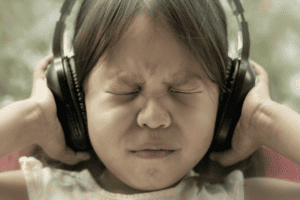(Listen to this content instead on our podcast) (Leer en español)
Jack is late for school again because his sock is just not fitting the right way. “The lines are wrong!”
Sarah is a bundle of joy as she bounces from room to room but it’s exhausting trying to keep up with her need for movement.
I work with families interested in supporting their children’s learning and development. Many of these families are seeking help because it is hard for their child to remain calm and engaged at school or at home. Sometimes this is fairly easy to identify (i.e. “Jackson runs out of the room every time we do math”). But sometimes it is more complex (i.e. “Gillian sometimes puts her head down in class or rushes through work, but not all the time, and sometimes there’s a lot of conflict at home”). When I meet with these parents, I always ask about their child’s sensory likes or dislikes. But why?
I ask about the child’s sensory profile because this helps me start to understand the child’s experience in the world.
Many of us have kids who need headphones to block some noise in the auditorium, or a wiggly seat to sit on during ‘quiet’ time. Sometimes kids will have built-in body breaks, or I’ve even seen desks with bike pedals attached so the child can keep moving while sitting. These are great ideas! And they are often very useful. But the magic is not in finding a few things that work for some, the magic is in better understanding your child’s sensory profile and building in support from there.
Sensory integration was studied extensively by Jean Ayres (1976/2005) and is defined as the process by which people register, modulate, and discriminate sensations received through the sensory systems. Does your child seek sensation or do they avoid it? Maybe it’s different for different sensory systems?
So, what are the sensory systems we’re talking about?
Lindsey Biel, OTR/L, MA and Nancy Peske have graciously permitted us to share the sensory checklists below, adapted from the book Raising a Sensory Smart Child: The Definitive Handbook for Helping Your Child with Sensory Processing Issues.
Touch.
Maybe your child loves to be touched (“draw on my back!”) or maybe they hate it. If you love touch, it might be confusing if your child avoids your hugs – but some of these “sensory avoiders” describe their underwear tags as feeling like sandpaper on their lower back.
Here are some of the ways sensitivity to touch might show up in your child:
-
Loves or hates being touched on some body parts, hugs and cuddles
-
Certain clothing fabrics, seams, tags, waistbands, and cuffs feel terrible
-
Always wears clothing, shoes, or accessories that are very tight or very loose
-
Loves or hates getting hands, face, or other body parts “messy” with paint, glue, sand, food, lotion, etc.
Proprioception, or body sense.
I can best describe this sense by thinking of my child who would jump on a trampoline all day if he could and chomps on cucumber like it’s going out of style. He is a seeker. But we have a good friend who is an avoider. He feels really agitated when the blindfold covers his eyes during a piñata activity. It is disorienting and dysregulating for him.
Here’s what it might look like in your child:
-
Constant rough-housing, bouncing, or hanging
-
Avoidance or a love of very crunchy or smooth foods
-
Difficulty with fine motor tasks like writing or playing with snap-together toys
Vestibular, or movement sense.
Seekers will say, “More swinging!” or they will spin in the kitchen until they fall down, unfazed. Avoiders do not like the feeling of being unstable or being asked to do things like somersaults.
A child who struggles with this sense might:
-
Enjoy being moved passively by another person (rocked or twirled or pulled in a wagon)
-
Avoid less stable ground surfaces like thick carpet, sand, or snow
Auditory, or listening.
Some of us may feel really calm when listening to Gregorian chanting and others may feel like we’re going to crawl out of our skin. I have one kid that becomes overstimulated immediately when in the movie theatre and another who loves it while it’s happening and then has a hard time recovering from the stimulation when we leave.
Here’s what this might look like in your child:
-
They watch TV at a very high or very low volume
-
They need background noise like music or a dishwasher when they are working on a task
-
They don’t like singing with other people
-
They get easily overwhelmed by loud places
Vision, or how we see and interpret what we see in the world.
Is it calming for me to create lines of objects or look at wheels spinning, or does my nervous system go into overdrive when lots of light flashes across the screen?
Your child may:
-
Struggle with activities that need a lot of hand-eye coordination
-
Be sensitive to bright light
-
Feel overwhelmed in visually “busy” places like a grocery store
Taste/Smell.
Any patterns you can identify with your child’s sensitivity or avoidance of certain tastes or smells? Do you have any memories of things you loved to smell or taste, how did it make you feel?
Your child may:
-
Resist trying new foods
-
Love strong-tasting foods like pickles, olives, or hot peppers
-
Gravitate towards the same food all the time
These checklists are not going to give you any answers. It’s better than that. They are going to give you information.
They are giving you an opportunity to think more deeply about how your child is walking through the world. Maybe you’ll reflect a bit on how you are walking through this world. And if you’re lucky, that may lead to you thinking about how you each have your own likes and dislikes that show up in your interactions with one another, or other family members.
I’d love to hear what you’ve learned. Drop us a line on social and share with us. Or if you’re wondering where to go next, check out the Resource Directory to find an Occupational Therapist in your area (Massachusetts/Louisiana). You can ask your service provider about a sensory diet for your child or if you are concerned about your child’s sensory integration challenges impacting daily life, contact your doctor and let them know you’re seeking an assessment for Sensory Processing Disorder.
I’m off to eat something crunchy and wrap myself in something soft and warm. What do your senses need?
Some resources that might be helpful:
Kitchen Conversations: Occupational Therapy at Home
What do you mean, “self-regulation is the new IQ”?
Keeping calm: mastering the art of self-regulation in three simple steps




